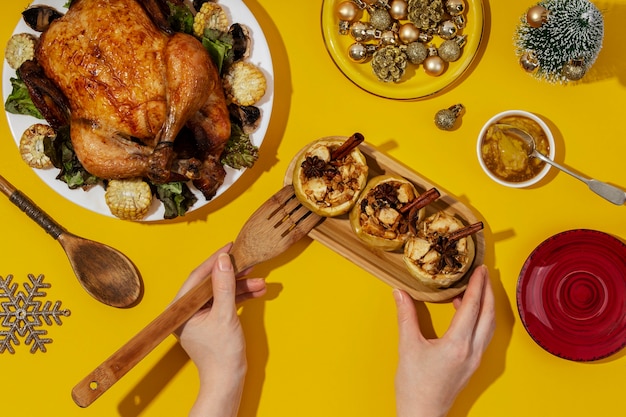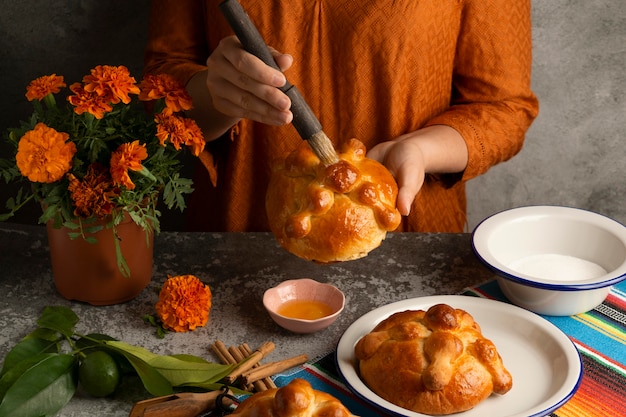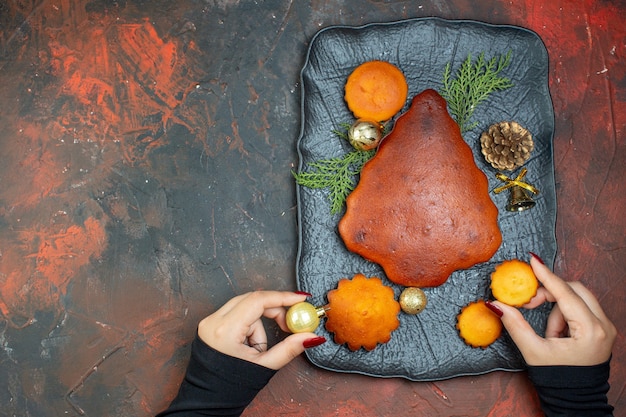Ah, the glorious Christmas turkey. The centerpiece of the festive feast, the symbol of a hearty and joyous gathering. But when you're facing a 23lb bird, the sheer size can be daunting. How long do you roast it? How do you ensure it's cooked perfectly, juicy, and tender, without turning into a dry, rubbery disappointment? Don't worry, my fellow foodie, I'm here to guide you through the turkey roasting time conundrum. Let's embark on this culinary adventure together, shall we?
(Part 1) The Big Bird: A Beast of Burden

My love for a big, juicy turkey at Christmas is a deep-seated one. It’s simply a tradition, a comforting ritual that brings families and friends together. But my very first encounter with a 23lb turkey was, to put it mildly, a baptism by fire. The sheer enormity of the thing, the weight of responsibility – it was overwhelming! I’d always handled smaller turkeys before, but this was a whole new level of cooking. And after a few botched attempts (and a few dry, tough turkeys to prove it!), I learned a thing or two.
The Science of Turkey Size: It's All About Heat
The bigger the turkey, the longer it takes to cook through. Why? It's all about heat distribution. Imagine trying to heat a massive pot of water versus a tiny cup. The large pot will take far longer to reach the desired temperature, right? The same principle applies to a turkey. That vast expanse of meat requires more time for the heat to penetrate and cook it thoroughly. If you cook it too quickly, the outside might be perfectly browned, but the inside will remain raw and undercooked – not a scenario any of us want!
Debunking the "Per Pound" Myth: Not a One-Size-Fits-All Solution
You've probably heard the old saying: cook a turkey for X minutes per pound. While it's a useful starting point, it's not a magical formula. Here's why: First, it doesn't account for the turkey's shape. A long-legged bird will cook differently than a rounder one. Second, oven temperatures can fluctuate greatly, even between different ovens in the same kitchen. So, while the "per pound" rule can be a guideline, it's not a foolproof method.
(Part 2) Temperature: The Unshakeable Constant

Okay, so we've established that roasting time is a bit of a variable. But one thing remains constant: temperature. It's the key to achieving that perfect, juicy, golden-brown turkey. We need to cook the inside to a safe temperature while preventing the outside from overcooking.
The Temperature Trifecta: Mastering the Art of Cooking
This is where a trusty meat thermometer comes in. It's essential! Here’s the temperature trifecta you need to nail:
- Oven Temperature: 325°F (160°C) is the sweet spot for a slow, even cook. This allows the turkey to cook through without drying out.
- internal temperature: The turkey is safe to eat when the thickest part of the thigh registers 165°F (74°C). This ensures that the bird is cooked thoroughly.
- Resting Temperature: After removing the turkey from the oven, let it rest for 30 minutes, covered loosely with foil. This allows the juices to redistribute throughout the bird, resulting in a moister, tastier turkey.
(Part 3) The Roast: A culinary journey

Alright, now it’s time to get our hands dirty! Let’s discuss the actual roasting process, the part where we truly transform a raw turkey into a culinary masterpiece.
Prepping the Bird: A Little TLC Goes a Long Way
First things first, give your turkey a good scrub. Rinse it inside and out, pat it dry with paper towels, and remove any giblets or neck from the cavity. Now, here’s where I like to add my personal touch: I stuff the cavity with a mix of aromatics – onions, garlic, lemons, and herbs. It creates a delicious fragrance and infuses the meat with a subtle, aromatic flavour. But if you're not into stuffing, simply add some butter and salt to the cavity. It will still add a delightful depth of flavour.
Brining: A Secret Weapon for Juicy Success
Here’s a secret I’ll gladly share: brining your turkey is a game-changer. It involves soaking the bird in a salt solution for several hours. This process helps to retain moisture and prevents the turkey from drying out during cooking. It also makes the meat incredibly tender and flavourful. Think of it as a spa treatment for your turkey! Just be sure to dry the bird thoroughly before roasting.
Roasting Time: A Slow and Steady Process
Now, pop that turkey into the oven! For a 23lb bird, expect a roasting time of 3-4 hours. Remember, it's all about the internal temperature, not just the time. Keep a close eye on that thermometer and don’t hesitate to check it every hour or so. During the first hour or two, resist the temptation to open the oven door. This helps maintain a consistent temperature and prevents the turkey from losing heat.
Basting: The Golden Touch for a Delicious Crust
Basting is a simple yet effective way to achieve that beautiful, golden-brown skin. Use a turkey baster or a spoon to regularly pour the drippings from the bottom of the roasting pan over the bird. This keeps the skin moist and helps it brown beautifully. I usually start basting after the first hour and continue throughout the roasting process.
(Part 4) The Rest: A Moment of Patience
Once that magic 165°F internal temperature is reached, it's time to take the turkey out of the oven. But don't carve it right away! The resting period is crucial for allowing the juices to redistribute throughout the bird. Cover the turkey loosely with foil and let it rest for at least 30 minutes. It may seem like an eternity, but trust me, it's worth the wait. Your turkey will be incredibly juicy and tender, and the flavours will be more intense.
(Part 5) Carving: A Triumphant Moment
Alright, now it's time for the big reveal! This is the moment you've been waiting for. carving a turkey can seem intimidating, but it's actually pretty straightforward. You'll need a sharp carving knife, a cutting board, and a carving fork. Here's the easiest way to carve a turkey:
- Remove the legs: Start by carving the leg and thigh from the bird. Cut along the joint and use the carving fork to hold the leg in place as you carve.
- Separate the thigh: Separate the thigh from the drumstick by carving along the joint.
- Carve the breast: Carefully carve slices of breast meat, making sure to avoid the bones.
You can slice the meat into thin, even pieces, or leave it in larger chunks, depending on your preference. And don’t forget to save those precious drippings! They're the key to making a delicious gravy to pour over your turkey.
(Part 6) Serving: A Feast for the Senses
Finally, it's time to feast! Arrange your beautifully carved turkey on a platter and surround it with all your favourite sides. Don’t be afraid to get creative with your presentation. I like to add some fresh herbs, sprigs of rosemary, or a few slices of lemon for a touch of colour and fragrance. It's all about creating a festive atmosphere that celebrates the occasion.
(Part 7) The Leftovers: A Culinary Treasure
Let's face it, no one wants to waste a single morsel of that delicious turkey. That’s where the leftovers come in! I’ve got a whole repertoire of recipes for using up leftover turkey. It’s a fantastic opportunity to get creative and experiment with flavours. You can make turkey sandwiches, turkey soup, turkey curry, or even turkey pot pie. The possibilities are endless!
(Part 8) Mastering the Turkey: A Personal Journey
Let's be honest, mastering the art of roasting a turkey is a journey. It takes time, practice, and a bit of patience. But trust me, the rewards are worth it. It’s incredibly satisfying to see that beautiful bird emerge from the oven, golden brown and glistening. And the look on your guests’ faces when they taste your perfectly cooked turkey is truly priceless. It's a moment to be cherished.
FAQs
Here are some frequently asked questions about roasting a 23lb turkey:
1. How long does it take to roast a 23lb turkey?
The roasting time for a 23lb turkey can range from 3 to 4 hours at 325°F (160°C). However, it’s essential to rely on the internal temperature, not just time. The thickest part of the thigh should register 165°F (74°C) for safe consumption.
2. Can I roast a 23lb turkey in a regular oven?
Yes, you can! However, make sure your oven has enough space to accommodate the turkey. You may need to adjust the cooking time and position the bird in the oven to ensure even cooking.
3. Do I have to stuff a 23lb turkey?
Stuffing is entirely optional. You can choose to stuff the turkey with aromatics like onions, garlic, and herbs, or simply add butter and salt to the cavity. If you choose to stuff, stuff it loosely to allow for steam to escape.
4. Can I freeze a 23lb turkey?
Yes, you can freeze a 23lb turkey. Wrap it tightly in freezer paper or plastic wrap to prevent freezer burn. It can be frozen for up to 2 months.
5. How do I tell if a 23lb turkey is done?
Use a meat thermometer – it’s your best friend! The thickest part of the thigh should reach 165°F (74°C). You can also check the juices – they should run clear when the turkey is cooked through.
Everyone is watching

Corn on the Cob: The Ultimate Guide to Perfectly Cooked Ears
Healthy MealsAh, corn on the cob. Just the name evokes images of sunny days, barbecues, and that sweet, juicy flavour that ...

Perfect Pork Roast Oven Cooking Time: A Guide to Delicious Results
Healthy MealsThere's something truly satisfying about a perfectly roasted pork. The aroma alone is enough to make your mout...

Ham Cooking Time: How Long to Bake, Smoke, or Boil a Delicious Ham
Healthy MealsAh, ham. It's a classic, isn't it? A real crowd-pleaser, especially around holidays. And when done right, it'...

Scallops: The Ultimate Guide to Perfect Cooking
Healthy MealsAh, scallops. Those delicate, sweet, and utterly delicious morsels of the sea. They hold a special place in my...

Spaghetti Squash: The Ultimate Guide to Cooking and Serving
Healthy MealsRemember that time you saw spaghetti squash at the supermarket, looking all bumpy and strange, and thought, "W...
